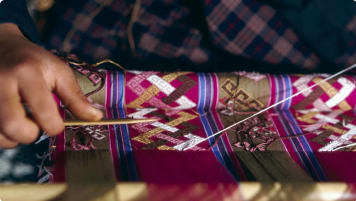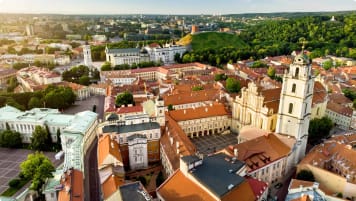Highlights of Lithuania | Hill of Crosses
Just outside the northern city of Siauliai lies a small hill in the middle of farmland that has been crowned with around 100,000 crosses in all different sizes. There are tiny crosses, massive wooden crosses and crosses handcrafted from metal. Known as the Hill of Crosses (Kryziu Kalnas), it is both a pilgrimage site and a testament to Lithuanian strength and defiance under Soviet rule. It has come to represent the peaceful endurance of Lithuanian Catholicism in the face of so many threats throughout history.
22 Jan 20 · 4 mins read
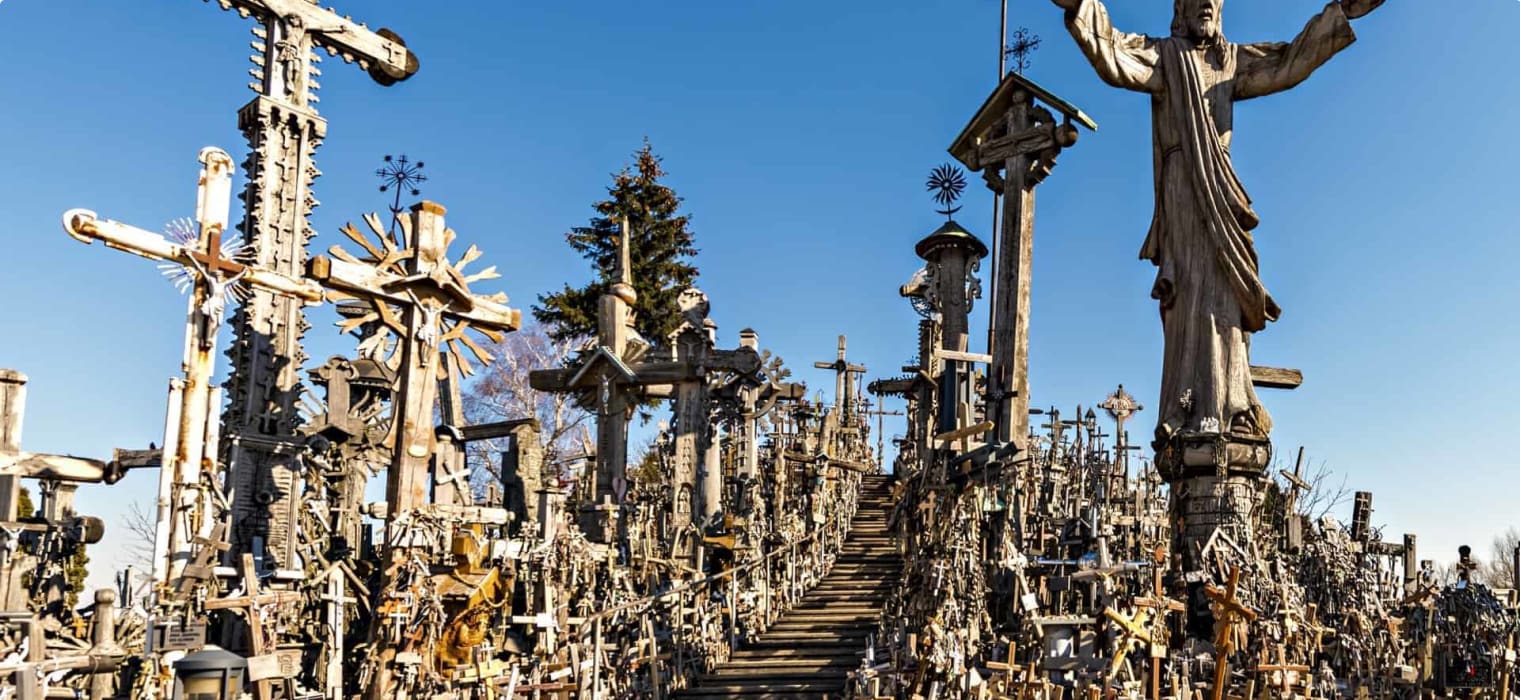
Highlights of Lithuania | Hill of Crosses

Situated near the northern city of Siauliai in Lithuania, the Hill of Crosses stands tall amidst vast farmland, adorned with over 100,000 crosses of various shapes and sizes. From intricate metal crosses to massive wooden ones, this site, also known as Kryziu Kalnas, serves as both a pilgrimage destination and a symbol of Lithuanian resilience during the challenging years of Soviet dominance.
It embodies the unyielding spirit of Lithuanian Catholicism in the midst of historical adversities. Regardless of one’s religious beliefs, the array of crosses, saints’ icons, and Jesus statues creates a striking and profound spectacle, illustrating why the Hill of Crosses holds such profound significance for many. For travelers, this sacred site is accessible with a two and a half-hour drive from Vilnius or just over an hour and a half from Riga.
The History of the Hill of Crosses

Following the 3rd partition of the Polish-Lithuanian Commonwealth in 1795, Lithuania became part of the Russian Empire. In 1831, Lithuanians and Poles staged an unsuccessful rebellion against Russian authorities, sparking the tradition of placing crosses on the hill to commemorate the rebellion’s victims. Families, unable to locate the bodies of fallen rebels, used crosses as a way to honor and remember them. The number of crosses grew after another failed rebellion in 1863 during Tsarist rule, when national identity and religious expression were suppressed, depriving families of the opportunity for proper burial ceremonies.
In 1918, Lithuania declared independence, transforming the Hill of Crosses into a site for prayer and reflection. Many Lithuanians visited the hill to pray for those lost in the war of independence. During the Soviet occupation from 1944 to 1990, the hill became a powerful symbol of resistance. Despite Soviet attempts to demolish the crosses, Lithuanians defiantly continued to erect them, showcasing their allegiance to their country, religion, and heritage. The Soviets viewed the hill as a threat to their authority, leading to repeated destruction of the site. Nevertheless, Lithuanians persisted, risking punishment to ensure new crosses appeared daily.
With Lithuania regaining independence in 1991, the hill was adorned with a multitude of crosses. In 1993, Pope John Paul II‘s visit to the site elevated its status as a place of hope, peace, love, and sacrifice. Today, the Hill of Crosses stands as a testament to the resilience of Lithuanian culture and unwavering faith. UNESCO has recognized cross-crafting as an integral part of Lithuania’s intangible cultural heritage, underscoring the hill as an exceptional example of this cherished tradition in action..
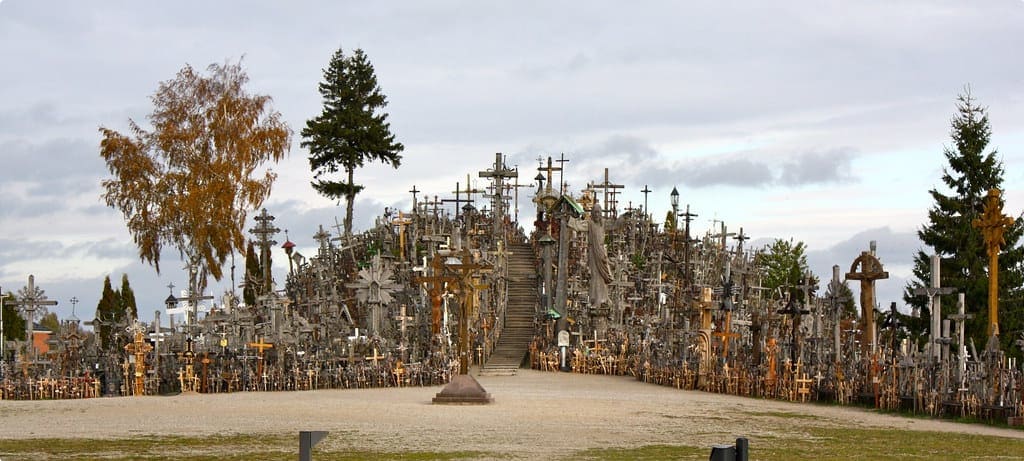
Visiting the Hill of Crosses
As local artist and historian Vilius Puronas articulated to the BBC, the Hill of Crosses symbolizes a collective ownership, belonging to all without any specific claim from the church or government. People are drawn to this site not out of obligation, but rather out of personal inspiration. The Hill of Crosses remains accessible to visitors 24/7 throughout the year, free of charge, allowing individuals to contribute by placing their own crosses on the hill.

A visit to the Hill of Crosses unveils two significant crosses deserving attention. The first showcases a seated Jesus, sheltered beneath a roof, engaged in private prayer with a solemn expression. This poignant representation mirrors the many Catholics who had to practice their faith clandestinely during the oppressive reign of the Russian government. The second notable cross, prominently positioned at the site, was gifted by Pope John Paul II after his visit in 1993. This large metal cross mounted on a marble base bears an inscription expressing the Pope’s gratitude to the Lithuanian people for their unwavering faith.
Beyond its haunting beauty, the Hill of Crosses narrates a profound tale of Lithuanian heritage and history. It serves as a poignant emblem of resilience, shedding light on the enduring hardships faced by the Lithuanian populace under oppressive political regimes. This monument stands as a powerful testament to a past of struggle and triumph, making it a compelling destination for a day trip from Vilnius.
For those captivated by the myriad Christian crosses adorning this sacred hill, our Baltics tour offers an enriching experience. Travelers on this tour have the opportunity to explore the Hill of Crosses en route to Riga. To delve deeper into the allure of Lithuania, do explore our detailed country profile for further insights.

Articles about Lithuania published by Odyssey Traveller:
- Questions about Latvia.
- History of the Baltic States.
- Guide to the Baltic States.
- Highlights of Latvia: Rundale Palace
- Highlights of Latvia: Turaida Castle
- Highlights of Latvia: Riga Cathedral
- Highlights of Latvia: Trakai Island Castle
For all the articles Odyssey Traveller has published for mature aged and senior travellers, click through on this link.
External articles to assist you on your visit to Lithuania:
Related Tours
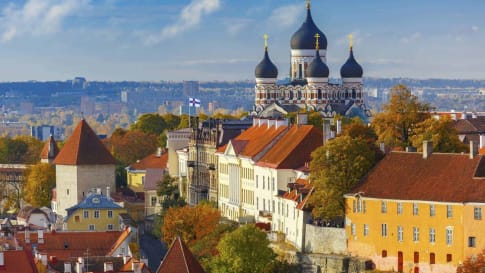
21 days
Sep, MayBaltics Small Group Escorted Tour: Latvia, Estonia, Lithuania
Visiting Estonia, Finland
An escorted small group tour to the Baltic States of Europe that explores the key destinations of this region starting in Berlin, then making its way through Poland, Estonia, Latvia, Lithuania, Finland and concluding in St. Petersburg. Each day has scheduled itineraries supported by local guides who share knowledge and authentic experiences of the places visited. This is small group travelling to the Baltics for like minded people.
From A$13,995 AUD
View Tour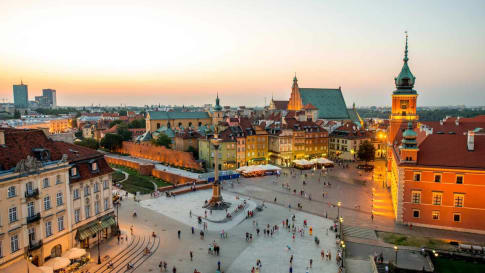
21 days
Jun, Sep, May, OctExploring Poland | Poland Small Group Tour
Visiting Poland
Odyssey's European tour of Poland provides the guests with authentic experiences in a range of key historical destinations to enjoy. Your tour leader supported by knowledgeable local guides who provide daily itineraries that often take you off the beaten path to learn more about the places visited.
From A$13,340 AUD
View Tour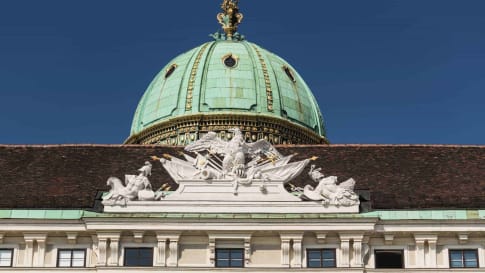
22 days
AugHabsburg Art and Classical Music small group Tour
Visiting Austria, Czech Republic
From the mediaeval jewel of Cesky Krumlow to the grandeur of the Habsburg’s summer palace in Vienna, our small group will embark on a 21 night journey to learn about these vibrant and artistically rich cities. We delve into the history of the famous artists, musicians, writers, architects and composers from Austria, Hungary, Poland and the Czech Republic.
From A$15,245 AUD
View Tour
